

Hamamelis Gold Star
Most shrubs are flowering shrubs, but some have flowers that are so insignificant, that other characteristics make them popular. For instance, the Dogwood types of Cornus, have flowers flowers for a short period of time.
But they are not grown for their flowers, rather generally grown for the autumn and winter stem colour and or their autumn leaf colour. The coloured 'bark' may well be the ancestry of the common name of Dogwoods. For a stunning display of winter stem and bark colour - visit to dogwoods.
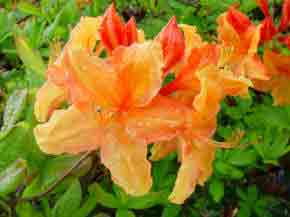
Orange Azalea
Talking about Winter Brrrr - Winter Flowering Heathers are a good choice for all year round colour.
Then again, there are other Cornus varieties that are grown specifically for their flowers, but have no winter stem or bark colour worth talking about. Herein lies a problem with shrubs - that of nomenclature - in particular their common names. All of the Cornus varieties are known under the common name of 'dogwoods'.
Best of the red bark dogwoods by far is Cornus Alba Sibirica. The only turn off is that it has normal green foliage. Six months of spectacular red stems in the middle of winter must surely make up for that.
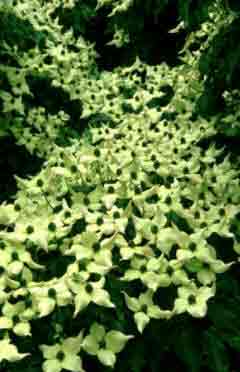
Cornus kousa
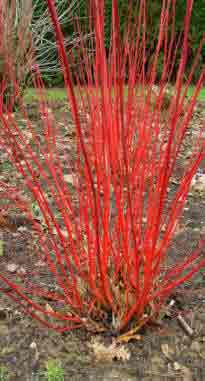
Cornus alba Sibirica
On the left, we see the Cornus kousa, which is grown for its masses of flowers in early summer, but has no winter stem colour. The image on the right is of Cornus alba Sibirica. This is grown for its stem colour which lasts from leaf fall right through until the following spring. Both types have stunning autumn foliage colour, but this will last for just a few days - or maybe a week if the weather is mild!
Don't let the examples above put you off growing shrubs in your garden. Shrubs are generally easy to grow and care for - as we will show you in this section of the site. Whatever spot in your garden - be it a small isolated space, or a whole difficult dry bank - there will be shrubs to suit. many will have long periods of interest - either by flower or their foliage. Others may just flower for a short time - but with flowers or scent so exquisite that they just have to be grown!
The two broad classes of garden shrubs are Evergreens and Deciduous. Within both these categories, we have flowering, foliage, low, tall evergreen shrubs, slow growing, quick growing, shade loving shrubs, sun loving shrubs. In fact, shrubs for the garden - the list is almost endless. But, if you want a low growing flowering shrub with evergreen foliage and flowers in the winter, there will most certainly be one. There will also be a tall growing summer flowering shrub that has deciduous but colourful foliage. This then, is the versatility of shrubs. Whatever your situation, the will be a shrub to suit! A bold statement which we will try to prove in this section about garden shrubs.
However difficult your garden situation is, then there will almost certainly be a shrub that will grow in it. Maybe several! Shady damp spots can be catered for with shrubs that are happy in shade and damp conditions, and of course there are many shrubs that will thrive in exactly the opposite conditions - shrubs dry sunny areas.
No wall or fence in the garden need to be bare, for there will be climbing shrubs for any such position, together with screening shrubs, groundcover shrubs, hedging shrubs and shrubs that provide edible fruit. If that does not enthuse you, then throw in the fact that they are normally easy to grow, and will often last for many, many years.
All of the great landscape gardeners used shrubs in their garden schemes, and of course some of the lesser garden designers also include shrubs in their planting schemes. The single most important aspect of successful shrub planting, is to plant the right shrub in the right place. Many a garden scheme has been ruined by the inclusion of particular shrubs that have been planted in the wrong place! Don't let it happen to you or your garden.
I have seen many gardens that fail to reach their natural maturity because shrubs have to be ripped out after years of pruning have not remedied the fact that a shrub has been planted in the wrong place - usually without adequate thought or knowledge as to the ultimate size of the shrub once it reaches maturity. Or worse still, having that knowledge - and ignoring it. Believe me it happens. A lot!
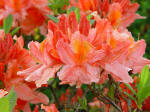
Rhododendrons
All common garden shrubs can be found from this page, with links to the alphabetical listing of common Garden Shrubs.
Brief details of shrubs are included with full shrub details on linked pages.
You can always use the search, if you know the name

Plant a Shrub
The best time to plant a shrub used to be autumn – with a few exceptions. Many writers will say anytime is ok for a container-grown shrub, and garden centres will agree, because it gives them ‘all year trade’. But the subject of when to plant a shrub is dependent upon several features.
There is a strong case for autumn planting of shrubs and many other hardy plants, but there is also a case to be made for year-round planting as well. Much depends upon the variety of shrub, and more importantly, how that shrub was grown at the nursery before it reached point of sale.
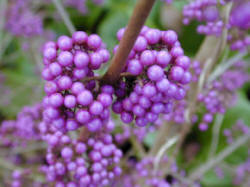
Callicarpa Profusion
I am already thinking that I have set myself an impossible task with this page title. Not because it will be difficult to think of ten good things about shrubs, but because it will be difficult to limit the advantages of growing shrubs to just 10 choices!
I have grown shrubs as a nurseryman; I have sold shrubs as a garden center owner; I have planted shrubs as a gardener and not least, I have studied shrubs as a plant photographer.
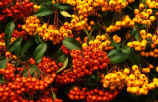
Pyracantha Orange Charmer
Shrubs have berries for a reason. They are an vital part of the plant's reproductive method. Berries are eaten by birds or animals, who are only interested in the juicy fleshy part of the berry. After eating the berry, the animals wander off to other areas, and eventually deposit the seed part of the berry, which has not been digested in the stomach, so passed through the body in the normal way.

Daphne
Flowering shrubs are an important part of the garden plan. Whereas most shrubs flower, some are more long lived or otherwise better than others.
Flowering or evergreen, all shrubs have an important role in the garden, with their diverse shapes and wide range of planting applications. Nonetheless, it is those shrubs that are classed as flowering shrubs which are more widely sought after.
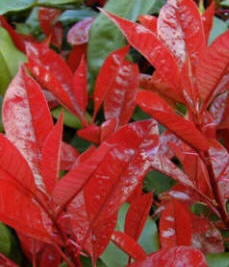
Photinia
Evergreen shrubs for the garden. Colour in the Foliage
The term evergreen shrubs often conjures up visions of banks of dark evergreens, such as were planted by Victorian gardeners, and latterly in the public parks of the UK.
Nothing could be further from the truth, for modern evergreens have many new forms and varieties that can transform a garden border - if not into a riot of colour - certainly an area which features virtually every colour imaginable, and often with more colour - for longer periods - than many deciduous flowering shrubs.
Cotoneaster Coral Beauty
Many shrubs that grow tall also grow bushy – a fact sometimes overlooked in the quest for screening or privacy. Defining what a tall shrub is can be fraught by problems, for no two gardens (or gardeners) are alike. Some would consider 6 feet (1.8m) to be tall; for others, that would be a medium sized shrub.
This list is by actual physical height that can be reasonably expected in around ten years of growth. Some shrubs will reach full mature size in just a few years, whilst others will eventually get there in a more leisurely timeframe. All of the shrubs mentioned, will carry on growing – sometimes well in excess of the 1.8m guide.
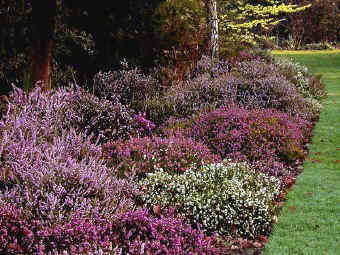
Winter Heathers
Unlike their summer-flowering counterparts, the winter flowering Ericas (Heaths) are not too fussy about the type of soil they are planted in. They will live quite happily in alkaline (lime) soils, whereas the summer flowering types will only thrive in an acid soil.
As can be seen in the picture, they also make good ground covering plants. There are also many fine coloured foliage types to be obtained.
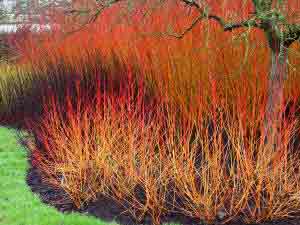
Cornus and Willows
The attractive bark on many shrubs can give you true winter colour in your garden for up to five months. Colour and interest that hits you right in the face; not needing you to go searching for it beneath leaf litter, hidden in a mass of evergreen foliage or only appearing when the sun is out. Winter coloured stem bark on shrubs is not as popular as some of the choice flowers that put in an appearance for a short time in selected winter months. It should be!
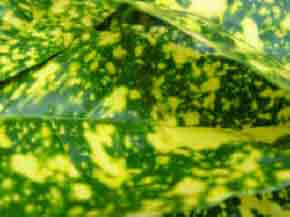
Aucuba
There are several reasons why shrubs can be used for ground cover. Suppressing weeds is the normally accepted use but carpets of shrubs can have many more attributes than simply stifling weed growth. A dense carpet of ground covering shrubs simply put down for weed control can often be more of a problem that the weeds that were supposedly smothered.
An area to be planted with ground covering shrubs is no different to any other area. It has to be properly prepared. Simply planting a few shrubs in a bed of weeds does not work. More often than not, the weeds will continue to grow and possibly smother the shrubs. Not a good start to the project, but happens so many times
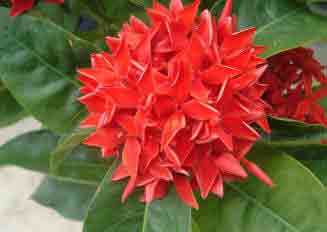
Ixora - flowering shrub
The days of poor choice and unavailability of colourful shrubs has long gone. In fact, I would argue that there has always been wide choice, but a choice not always taken advantage of! These days, with the surfeit of garden centres and nurseries - pushed forwards in quality and display expertise by the superstores - there is a huge range of shrubs always available.
One of the biggest mistakes I see from amateur gardeners attempting their first - sometimes last - shrub borders, is the basic error of not allowing enough room for the shrub to develop into whatever it will! Basically, planting it in the wrong place.